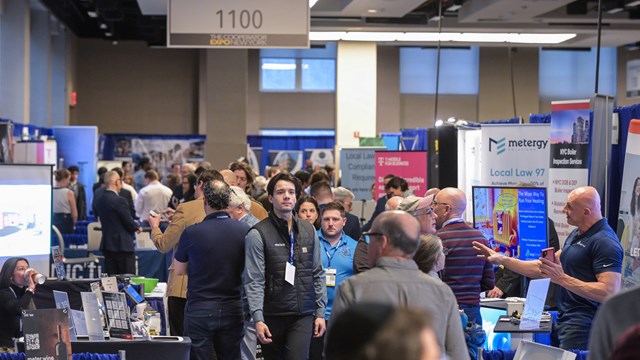
Most co-op and condo buildings have a common laundry room for residents to use instead of washers and dryer units in each apartment. Laundry rooms are more than just an amenity; to some, they are practically a necessity, and the operation and maintenance of laundry rooms has drastically changed over the years.
In the past, laundry rooms usually consisted of several washers and dryers purchased by the management (sometimes even old, used models), stored in often the darkest regions of the building's basement. Residents would use the machines and management would collect the quarters as revenue to pay for the cost of the units and its maintenance and repairs. More often than not, the laundry room did not generate a steady enough profit for the building, and maintenance was ignored, leaving unusable machines and agitated residents.
Today, most management companies feel comfortable to outsource the care of nearly all co-op/condo laundry rooms to outside laundry contractors. Laundry room facilities have improved tremendously through new technology and buildings may even gain a moderate revenue stream from the amenity.
"The laundry room is now a main consideration, not an afterthought," says Ed Kwitko, vice president of Hercules Corporation in Hicksville, New York. "Everyone wants a washer and dryer that does the job and a room that is not a horrible chore [to go to]. They want a room that's bright, comfortable and safe and a room where there are the right number of machines to handle the residents in the building."
Bringing one's laundry facility up-to-date and to the highest standards is one of the keys to a more efficient operation, says Service Directions Inc. president Ron Garfunkel. "Technology is moving so quickly these days, and end-users unfailingly want the most efficient, most convenient and highest quality machines and services. Without exception, we have found that property decision-makers, who allow us to present and implement the most current options on their behalf are the ones who experience the highest level of satisfaction from their laundry service end-users. And this translates into fewer complaints from the end-users and greater revenue for the properties."
Laundry contractors, also called route operators, will construct new or remodel existing facilities if needed, including the installation of plumbing, tiling and painting. Contractors will add equipment, such as washers, dryers, tables, carts and chairs.
When working with a contractor, Kwitko explains that there are two possible contract options. The most common contract is for five to seven years, during which the laundry contractors compensate the building management with a rental fee for the room. The contractors also maintain and service the machines when necessary. The contractors collect the money from the machines, using it to pay off the costs of the equipment and pay the building a revenue percentage, if it's in the contract. The contractors earn a profit after these costs are covered.
"Most laundry companies make a profit, but it's not a huge profit margin," says Mike Arbus, regional sales manager of Mac-Gray Services in Hoboken, New Jersey. "There's the investment of the equipment, any renovations including plumbing, flooring and ongoing costs to provide a 24-hour service to equipment."
A less typical contract is agreed upon when management purchases the equipment and the laundry contractors are only hired to service the machinery. "But that kind of arrangement is the exception, rather than the rule," says Kwitko.
According to Denise Savino-Erichsen, vice president of Automatic Industries in Hempstead, New York, laundry rooms can still be a profit center for the buildings too. "If the equipment is Energy star-rated, there's no reason why buildings can't make money from this. The building will pay utilities, but there should still be money left."
Although laundry rooms traditionally don't generate a huge profit, co-ops do have to abide by Section 216 of the Internal Revenue Service (IRS) tax code, more commonly referred to as the 80/20 rule. 80/20 limits the amount of commercial revenue a co-op building can take in during a year to 20 percent of the building's total cash inflow. The other 80 percent has to come from the shareholders' fees, maintenance charges, or special assessments. If a building's outside income slides one percent past 20, shareholders forfeit valuable tax write-offs and abatements. With that in mind, management must be careful that the building's total revenue - including a laundry room - stays within those guidelines.
Making money and making the residents happy start with negotiating the best contract for everyone. "One of the most important things to remember about a contract is the condition of the equipment," said Savino-Erichsen. "Make sure your laundry company is using new and not refurbished equipment."
Mike Madison, route operator for Birchwood Coin in Whitestone, Queens, agrees, but stresses that the brand of the new machine is just as important. "Management should learn about the different types of machinery. Ask about the brand of machine that you are getting, because certain brands aren't as superior as others. The better brands may cost us more to buy, but there'll be fewer problems for the building in the long run."
Service Directions, according to Mark Eisler, vice president of sales, sells Maytag products exclusively and their high-efficiency washers and dryers are advertised to save buildings money on hot water, gas and energy consumption.
To determine how many machines are needed in new construction or existing buildings, the contractors will assess the building, unit size and family size. "It's an enormous formula," says Savino-Erichsen. "It depends on the number of apartments, but the building could have large apartments with many families, or you could have a large building, but with mostly singles and couples or seniors who don't need as much equipment."
According to the guidelines laid out by the Multi-Housing Laundry Association (MHLA) - the North American trade association of companies offering professional laundry systems and services to the multi-housing industry, "In garden-style (low-rise) housing projects, builders should provide sufficient number of laundry rooms for each block or wing of units, with placement of not more than 200 to 250 feet from any apartment unit. In high-rise housing projects, builders should provide a laundry room on each floor or no less than one laundry room per two floors in a building with eight or more units per floor. More rooms should be provided per floor if the distance from any apartment unit exceeds 300 feet."
The MHLA also provides water conservation guidelines for washers, a common concern among building owners and management. However, the MHLA has found that common laundry areas actually conserve more water than in-unit washing machines. The study compared the washing machine water usage rates in rental units versus coin-operated machines in common laundry rooms and found that in-unit washing machines used an average of 11,797 gallons of water per year. In contrast, coin-operated machines in common laundry rooms averaged only 3,270 gallons per year - clearly a huge difference.
These figures point to significant savings on the utility bills of apartment building owners, including water, natural gas, electricity and sewage charges. They also translate into clear benefits for water conservation and wastewater treatment efforts. When negotiating a laundry contract, adding Energy Star approved washers can reduce water usage even further and ultimately improve your building's bottom line.
Another feature to consider is relatively new but becoming increasingly popular among co-ops and condos that are redoing their laundry rooms or upgrading their equipment. It's the Smart Card, a prepaid card system that eliminates the need for using coins in laundry equipment. Typically, residents must keep a supply of quarters on hand, or make change in the laundry room change machine. Laundry operators often report that collecting coins has led to theft, vandalism, and the pocketing of profits by whomever does the coin collection. One manager even reports that an unscrupulous superintendent was caught with nearly $5,000 in stolen quarters, and had been bilking the building for years beforehand.
The new Smart Card system eliminates the possibility of theft by allowing residents to purchase their laundry money ahead of time and add to it when it's depleted. To many boards and residents, that sounds much better than carrying a pocket full of change - though there are those who prefer the traditional approach.
Madison is among the Smart-Card critics. "I don't believe in the card system; it only benefits the route operator, because it cuts down on stealing, but it doesn't really help the building resident," said Madison. "If the tenant loses the card that has $10 on it, they lose the $10 on the card and they have to buy a card for $5 and put more money on it. I really don't think cards have done anything for the tenants."
Garfunkel, however, whose company first introduced the Smart Card in January 1994, disagrees with Madison. He believes the Smart Card offers better pricing flexibility. "Smart Card is a cash substitute, which makes it a little easier for the end-users because they don't have to find the necessary change." Service Directions is also considering a concept called plan-based washing, in which each card would have a pre-sold value on it. "It would be a Smart Card but with a special value station that would automatically revalue the card every month, back up to a plan limit. You would buy a laundry contract for a year and that would allow you so many uses a month. So it's very much like your cell phone."
Once the decision is made on smart card technology, washers, dryers and the design and feel of the facility, a contract is signed. It can be reassessed during the contract period if necessary because, as Savino-Erichsen says, "No contract is written in stone."
"We don't want to hear from you and hear that your machines are breaking down early," said Kwitko. "If you have a heavy-usage building, we may have to retire some machines early and reassess the contract for those machines, but we don't want you to be in bad shape."
If management decides to opt out of a renewal, the laundry contractors will simply remove the machines, tables and other accessories that they have purchased, but will leave the infrastructure intact. If management desires, they can usually purchase the equipment from the contractor.
"When we go into negotiation on a contract, we like building management to have an open mind and realize the primary focus of the laundry room is to have service for the residents - it's not really a huge money maker," says Kwitko. "Putting in the equipment provides residents with a great facility. The amount of income coming from laundry room is minimal compared to the important service it represents to the residents."
Thanks to energy-efficient machines, better lighting, increased security and proper management, residents are becoming much more satisfied with their laundry rooms. Taking time to invest in good equipment backed by a proper contract will pay off in the long run, and may help the building to clean up in revenues.






Leave a Comment